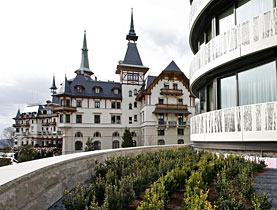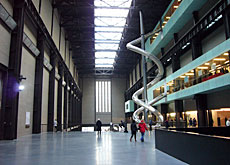Swiss architects urged to retain authenticity

The alpine chalet may be one of Switzerland's most enduring images but a new building could soon take over as its architectural icon.
At 154 metres high, Herzog and de Meuron’s tower block for Roche pharmaceuticals will be the country’s tallest building once complete in 2012.
Its potential for redefining Basel’s landscape will be on a par with the Swiss Re “Gherkin” in London – another corporate skyscraper delivered by star architect Norman Foster.
The use of famous architects to produce flashier, more impressive corporate symbols is a trend across the globe.
But as architects gathered for discussions in Lucerne, a call rang out to rein in this particular fad and look towards returning to producing architecture for the public at large.
Oasis of authenticity
Switzerland seems unsure whether it wants to be part of this trend or not, according to one expert.
“Either they are completely behind or are completely ahead,” explained Anna Klingmann, a New York architect and specialist on the conference theme of branding – the use of architecture to help create an identity for a place or a corporation.
“In either case I believe that Switzerland should just stay the way it is and not follow any trend because it is really a kind of strange oasis in all this mess that is circulating the globe. Switzerland is a preserved fragment of authenticity.”
It’s no surprise that tourists come from all over the world in search of that genuineness that is still preserved here, she added.
“As opposed to other places, Switzerland has no need to develop a new identity to position itself in the global market because it has already been positioned there for quite a long time, through its unique landscape and its financial market. So actually they can just sit back and relax.”
Glamour
Feted at its opening in 2000, the dramatic Culture and Convention Centre in Lucerne was an apt setting for the international conference on Architecture and Branding: or the Quest for the Garden of Eden.
Architects came from around Europe, the United States and China to ponder the next steps in city design and the branding movement, a common by-product of which sees the biggest names brought in to add a touch of glamour and international recognition to projects.
It was a phenomenon that came into its own with Frank Gehry’s design of the Bilbao Guggenheim Museum. As well as being visually stunning, the museum resulted in a major, sustained economic boost for the city.
The concept has been taken one step further with companies using architecture to create a total “brand experience”.
UN Studio’s Mercedes Benz Museum in Germany and the Rem Koolhaas’s design of the Prada flagship store in New York are among the foremost examples of these corporate brand spaces.
But concern has grown that many of these major projects do not fit in with the surrounding landscape or connect to the general public.
Homogenous
Klingmann argues that building signature and branded landmarks instead of more locally orientated structures has resulted in homogenous cities around the globe, with little originality left to distinguish them
She predicts that over the next decade the current trends will give way to the antithesis – a search for authenticity and uniqueness.
“The question is, especially in the Middle East where cities are created from scratch, how we can intentionally create differences? That can only be done by banking on the latent differences of cultures that are inherent in that place and using architecture to bring out those latent qualities,” Klingmann said.
“I think Switzerland and Zurich especially are examples of how old traditions can be bridged with innovation.”
Vals spa
Top Swiss architect Peter Zumthor has been cited as an example of how to pair traditional materials with fresh design in his thermal hotel project in Vals.
Zumthor used local quarried stone and a grass roof structure above the thermal spring baths, which are half-buried into the Graubünden hillside.
“It works like an urban attraction,” says Kerstin Höger, an architect and professor at the Institute for Urban Design in Zurich.
“Many people come because of the architecture, because it was designed by Peter Zumthor, a very good Swiss architect. It has a different, authentic feeling to it.
“But then Swiss architecture and architects are famous for being authentic and for being modest.”
Breaking the mould
Authenticity in architecture means being in dialogue with a place, its history and mood, the Lucerne conference organiser Frank Joss told swissinfo.
“We should be moving away from the megalomania of the past. We are not free of that in Switzerland, we are a bit victims of this behaviour that you can see all over the world where big names are engaged to do the nicest, the highest, the most surprising houses.”
While Switzerland may be tuned into producing locally relevant buildings, Joss says Swiss architects and urban planners will also need to break out from old moulds and embrace change if they want to stay ahead.
“We are afraid of doing something wrong, that’s typical Swiss behaviour. Instead of having courage and saying I will do the opposite to what you think I should do, we first ask what is the best way of avoiding problems.
“We should learn to respect our feelings, to respect that we have something to say and should not always ask which is the best that we can copy,” he added.
swissinfo, Jessica Dacey in Lucerne
Branding is the use of architecture to create an identity for a location, company or community. Frank Gehry’s Guggenheim Museum in Bilbao is seen as the benchmark of this concept.
Klingmann brand consultants in New York believe we are now in a ‘brandism’ phase, in which renowned architects are often called upon to improve the image of a company or a location, in the hope that their reputation will result in international recognition.
The use of big name architects is seen to minimise the risk for investors in the project. But at the same time it creates the possibility of building cities that are increasingly homogenous despite their cultural differences.
Klingmann say the next generation will be searching for authenticity and realism, forcing trends to move towards sustainable, unique architecture and cities. At that time, ‘no brand’ would become the ultimate brand.
Architecture Talks is a two-day international symposium which takes place every two years, and which is devoted to a theme in the fields of architecture, design and urbanism.
Architects, interior designers, contractors, investors and professionals come to the event to network and discuss trends and issues.
The gathering was started ten years ago by Frank Joss in a bid to create more interdisciplinary discussion around architecture.

In compliance with the JTI standards
More: SWI swissinfo.ch certified by the Journalism Trust Initiative












You can find an overview of ongoing debates with our journalists here . Please join us!
If you want to start a conversation about a topic raised in this article or want to report factual errors, email us at english@swissinfo.ch.